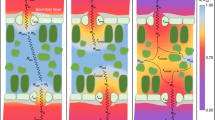Abstract
PROF. D. THODAY'S suggestion1 (apropos of the work of Dixon and Barlee2) of a possible mechanism of transpiration into a saturated atmosphere, based on the enhanced vapour pressure of convex water surfaces, is an attractive one, especially as it is a logical corollary of the older idea of the significance, in the water economy of a wilting leaf, of the subnormal vapour pressure of concave evaporating surfaces3. There are, however, certain difficulties in its application.
Similar content being viewed by others
References
Nature, 164, 541 (1949).
Sci. Proc. Roy. Dublin Soc., 22, 211 (1940).
Sresnevski, see Maximov, “The Plant in Relation to Water", 159 (1929).
Discussion of the Faraday Soc., No. 3, 159 (1948).
Author information
Authors and Affiliations
Rights and permissions
About this article
Cite this article
WILSON, K. Transpiration into a Saturated Atmosphere. Nature 164, 1013–1014 (1949). https://doi.org/10.1038/1641013b0
Issue Date:
DOI: https://doi.org/10.1038/1641013b0
- Springer Nature Limited
This article is cited by
-
Cause of the Absorption of Water by Submerged Shoots
Nature (1950)





